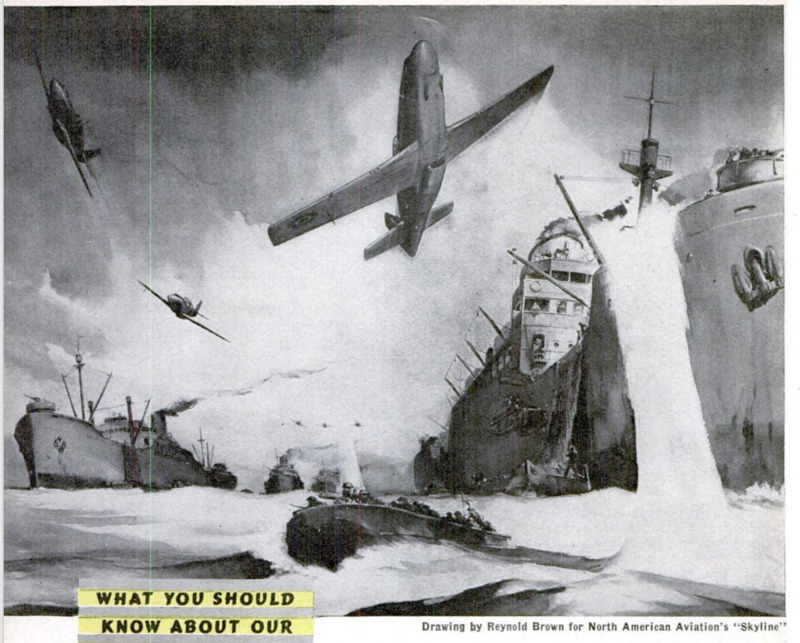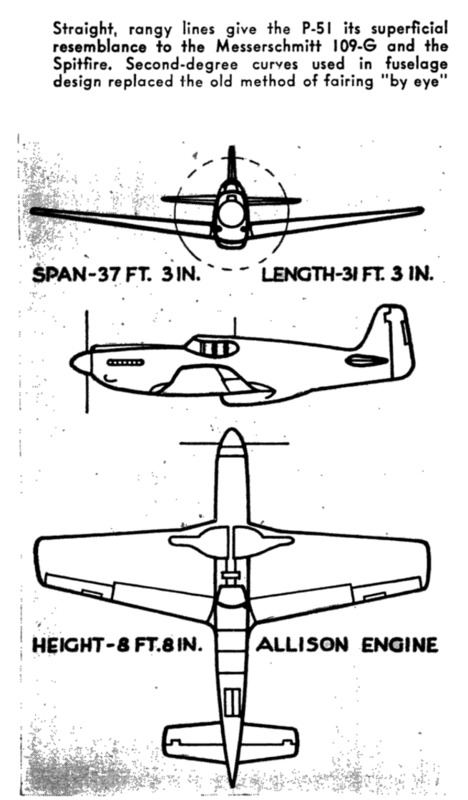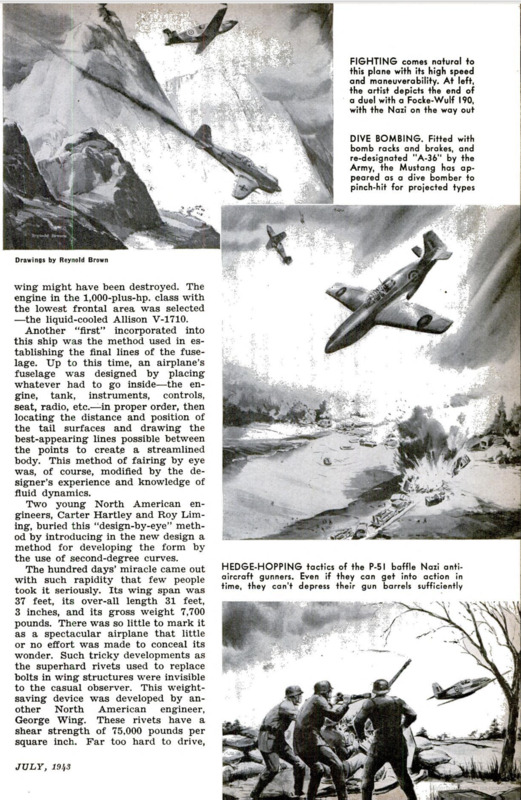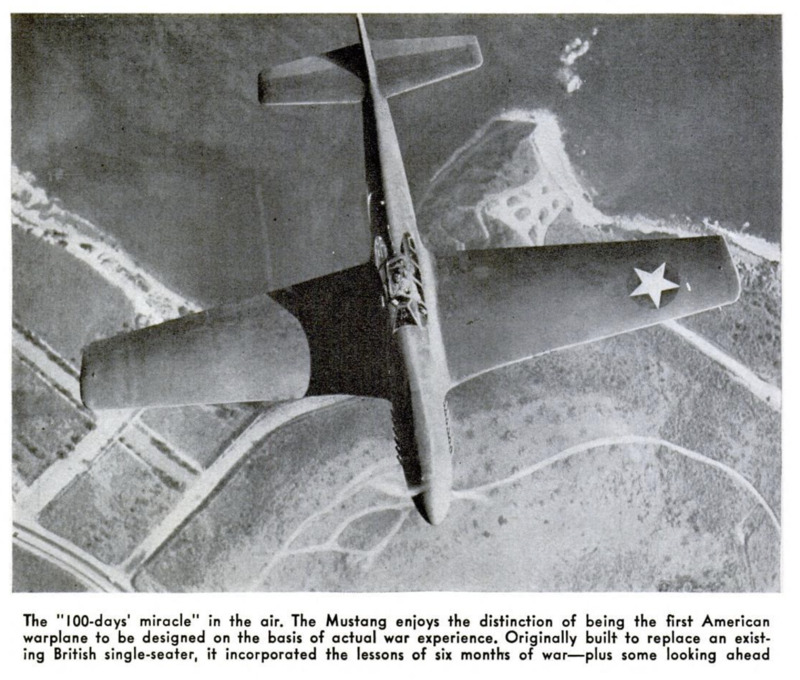-
Titolo
-
The P-51 "Mustang"
-
Article Title and/or Image Caption
-
A Fighter from the Ground Up. You'll be hearing a lot about the Mustang in the months to come. This is the story of the plane that brought something new to the war in the air.
-
extracted text
-
WHEN the history of this war is writ-
ten, there may be a hundred days
underlined in red pencil—a period in which
a young aerodynamic engineer and a veter-
an designer took a theory on airflow and
turned it into the deadliest change-of-pace
fighter airplane this stage of the war has
yet produced. They call it the North Amer-
ican Mustang—the P-51.
To the unpracticed eye, this latter-day
miracle may look like a half dozen other
fighters powered by liquid-cooled engines.
A careless spotter might turn it in for a
Messerschmitt 109-G. Its lean, rangy lines
are not unlike the Spitfire's, Indeed, they
are so conventional that little or no fuss
was made over the plane until it saw action
against the enemy.
The P-51 was probably the first airplane
designed from information gleaned from
actual war conditions. Scarcely six months
after England had gone to war with Ger-
many, the British Purchasing Commission
contacted North American Aviation on the
mass production of an existing single-
seater. Although the current product was
deemed adequate to match the existing
German ships, President J. H. “Dutch” Kin-
dieberger of North American and his staff
knew that the production victory was in
‘mass-producing an airplane that could out-
fly the best the enemy could produce at the
projected time in the future when these
craft would reach the battle line.
There had been six months of war, and
many things had been learned. Among
them was the need for high speed at all
levels, free from the effect of shock waves.
There was adequate evidence that aircraft
diving at speeds exceeding 400 miles per
hour encountered periods of excessive vi-
bration resembling impact or shock waves.
There appears to be a velocity at which
objects passing through the air no longer
are able to “part” the fluid body. In the
case of a curved surface designed to pro-
duce a definite aerodynamic result, like a
wing or tail surface of an airplane, the air
seems to “pile up” on the highest point of
the wing curve, forming stationary com-
pression or shock waves, The speed at
which the airflow alters as it approaches
the compression point is called the critical |
speed. This speed can be raised consider-
ably by careful shaping of the wing section
and relation of the wing to the fuselage
shape. |
With the results of six months of air
fighting before them, North American's
engineers tackled the problem of building |
a ship that would be a full year ahead of
its time when it first saw action. The major
problem was to control the smooth airflow
over the wings at high speeds so that the
ship could perform well at low altitudes
where the dense air offered high resistance
to the airplane, but still would have enough
performance to fight in the thinned-out
upper air if enough engine power were pro-
vided to take the ship there.
This was practically asking to have one's
aerodynamic cake and eat it. Two mem- |
bers of North American's staff came up
with a suggestion. Edgar Schmued, for-
mer Austrian pilot and now NAA’s chief |
design engineer, and Edward Horkey, a |
young aerodynamic expert, proposed the
use of the laminar-flow wing, a special
airfoil section developed in the wind tun-
nels of the National Advisory Committee
for Aeronautics. This wing had never been
used on anything more serious than a
wind-tunnel model. Admittedly, tests indi-
cated that the airfoil would operate with |
50-percent less resistance than an ordinary
surface capable of lifting the same amount.
Indications were that air would flow |
smoothly over its surfaces at speeds within
a few m.p.h. of that of sound. |
There were, however, several important
“buts.” The wing, to attain the hoped-for
efficiency, had to be mated with the slim-
mest possible fuselage; its surface had to
be absolutely rigid. Such a wing was diffi-
cult to produce in custom structure. Mass
production of such an airplane seemed im-
possible.
‘There was no doubt that the Axis had a
certain edge in time over the rest of the
world. They had been piling up not only
matériel but engineering information useful
in warfare. In order to head them off, a
certain amount of daring was required. By
normal engineering evolution, a sample of
the laminar-flow wing would have been
built and cautiously flown; in due time, an
airplane would have been evolved to fiy on
it. However, the world was in a hurry.
While Schmued and Horkey set about
developing production methods for getting
out large numbers of laminar-flow wings,
the fuselage had to be developed to conform
with the requirements of the wing idea. If
the air flowed turbulently around the fuse-
lage, the entire effect of the laminar-flow
wing might have been destroyed. The
engine in the 1,000-plus-hp. class with
the lowest frontal area was selected
—the liquid-cooled Allison V-1710.
Another “first” incorporated into
this ship was the method used in es-
tablishing the final lines of the fuse-
lage. Up to this time, an airplane's
fuselage was designed by placing
Whatever had to go inside—the en-
gine, tank, instruments, controls,
‘seat, radio, etc.—in proper order, then
locating the distance and position of
the tall surfaces and drawing the
best-appearing lines possible between
the points to create a streamlined
body. This method of fairing by eve
was, of course, modified by the de-
signer's experience and knowledge of
fluid dynamics.
Two young North American en-
gineers, Carter Hartley and Roy Lim-
Ing, buried this “design-by-eye” meth-
od by introducing in the new design a
method for developing the form by
the use of second-degree curves.
The hundred days’ miracle came out
with such rapidity that few people
took it seriously. Its wing span was
37 feet, ita over-all length 31 feet,
3 inches, and its gross weight 7.700
pounds. There was so little to mark it
as a spectacular airplane that little
or no effort was made to conceal Its
wonder. Such tricky developments as
the superhard rivets used to replace
bolts in wing structures were invisible
to the casual observer. This weight-
saving device was developed by an.
other. North American engineer,
George Wing. These rivets have a
shear strength of 75.000 pounds per
square inch. Far too hard to drive,
they must be forced into place by a.special
tool which presses the rivet's tiny collar
into the notched end of a stud, leaving a
modified conical head.
Excess length is sheared off automati-
cally. A thousand of these rivets—in reality
threadless holts—replace 798 heavier bolts
and some regular rivets in the wing alone,
effecting a 60-percent reduction in weight
in these materials.
The first ships to see action were low-
altitude fighters, operating for the R.A.F.
Their job was tagged “Army co-operation.”
Perpetual critics of U.S. designs accepted
that as a signal that the design was a fail-
ure and that the best use that the British
could find for the ship was as a successor
for the slotted and flapped Westland Ly-
sander. Nothing could have been farther
from the truth. At the point in the war
‘when the first Mustangs arrived, there was
nothing more vital to the conduct of the
war than accurate, instant information on
what the enemy was doing. The Lysanders
and other slow observation and photo-
graphic and reconnaissance ships had failed
to keep Intelligence posted, as their slow
speed had made them targets for anti-
aircraft and clay pigeons for fighters.
The maneuverability afforded by the ship
gave rise to constant use as a ground-
attack ship and fighter-bomber. Stripped of
all unnecessary weight and seldom flying
at altitudes greater than 1,000 feet, the
ships would fly into occupied France and
the Low Countries at treetop level. Radio
locating devices, which have to be deflected
slightly upward to clear ground obstruc-
tions, fail to pick up the low-flying craft
in time to repel it.
Because the Mustang is one of our “hot”
types, too much cannot be said about its
present and future. These are just conjec-
tures: That laminar-flow wing gets better
as it goes higher. All it needs is the proper
power plant to keep it there.
As to the airplane's behavior, little can
be said without telling the enemy some-
thing he should have to pay heavily to
learn. The best hint, however, comes from
the pilots. One of them is reported to have
wanted to return his extra flight pay.
Flying the Mustang was such fun that get-
ting paid for it seemed unnecessary.
-
Autore secondario
-
Andrew R. Boone (writer)
-
Reynold Brown (illustrator)
-
Lingua
-
eng
-
Data di rilascio
-
1943-07
-
pagine
-
69-72
-
Diritti
-
Public Domain (Google digitized)
-
Archived by
-
Matteo Ridolfi
-
Alberto Bordignon (Supervisor)







